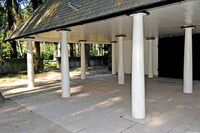| dc.coverage.spatial | Site: Stockholm, Stockholm (county), Sweden | en_US |
| dc.coverage.temporal | 1918-1920 (creation) | en_US |
| dc.creator | Asplund, Erik Gunnar | en_US |
| dc.date | 1918-1920 | en_US |
| dc.date.accessioned | 2013-07-25T14:52:33Z | |
| dc.date.available | 2013-07-25T14:52:33Z | |
| dc.date.issued | 1918-1920 | en_US |
| dc.identifier | 225933 | en_US |
| dc.identifier.other | archrefid: 2440 | en_US |
| dc.identifier.uri | http://hdl.handle.net/1721.3/133941 | |
| dc.description | Detail, portico columns of a proto-Doric order supporting the roof; Asplund’s early work vacillated between classicism and a National Romanticism influenced by his teacher Ragnar Östberg. A decisive success was the winning competition entry (1914-1915) for the Woodland Cemetery (grounds designed with his fellow student Sigurd Lewerentz). This project marked the beginning of each architect’s association with cemetery architecture. The Woodland Chapel is the cemetery’s first and smallest chapel. Asplund was inspired by the Danish Liselund estate on the island of Møn and created a simple wooden (covered with stucco) chapel surrounded by trees. The square exterior is capped with a rustic hipped roof on timber columns with classical domed space inside. | en_US |
| dc.format.medium | wood; stucco; wood shake roof | en_US |
| dc.rights | © Scott Gilchrist, Archivision, Inc. | en_US |
| dc.subject | architecture | en_US |
| dc.subject | death or burial | en_US |
| dc.subject | funerary art | en_US |
| dc.subject | Eclectic | en_US |
| dc.subject | romantic | en_US |
| dc.subject | Scandinavian | en_US |
| dc.subject | Pre-Modern | en_US |
| dc.subject | Twentieth century | en_US |
| dc.title | Woodland Chapel | en_US |
| dc.title.alternative | Skogskapellet | en_US |
| dc.type | image | en_US |
| dc.rights.access | Licensed for educational and research use by the MIT community only | en_US |
| dc.identifier.vendorcode | 1A1-AEG-WC-B13 | en_US |
| vra.culturalContext | Swedish | en_US |
| vra.technique | construction (assembling) | en_US |
| vra.worktype | chapel (room or structure) | en_US |
| dc.contributor.display | Erik Gunnar Asplund (Swedish architect, 1885-1940) | en_US |


